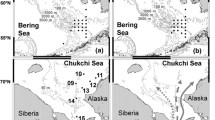Abstract
The bipinnaria larva of the shelf-dwelling asteroidLuidia sarsi Duben and Koren, 1845, can attain (exceptionally) a length of 35 mm; metamorphosis to the adult benthic phase usually occurs well before this size is reached. A seastar rudiment develops at the oral end of the bipinnaria and, under normal circumstances, it detaches itself from its larval body before reaching a diameter of 5 mm. Midwater trawl samples taken from the surface to 1650 m in the Porcupine Seabight during 1978 and 1979, however, includedL. sarsi larvae with post-larval rudiments of 15 mm diameter and greater. It is shown that the bipinnariae and attached post-larvae both continued to grow until a point was reached when it appeared that the young sea-star could no longer be sustained by the bipinnaria. There is evidence that the largest post-larvae had absorbed the bipinnaria tissue and this, it is concluded, is the final stage before enforced settlement. From the estimated growth rate it is likely that many specimens had been in the plankton for >1 yr, giving this species a capability for long-distance dispersal.
Similar content being viewed by others
Literature Cited
Baker, A. de C., M. R. Clarke and M. J. Harris: The NIO combination net (RMT 1+8) and further developments of rectangular mid-water trawls. J. mar. biol. Ass. U.K.53, 167–184 (1973)
Bouchet, P. and A. Warén: Planktotrophic larval development in deep water gastropods. Sarsia64, 37–87 (1979)
Bury, H.: The metamorphosis of echinoderms. Q. Jl microsc. Sci.38, 45–135 (1895)
Chia, F. and J. G. Spaulding: Development and juvenile growth of the sea anemone,Tealia crassicornis. Biol. Bull. mar. biol. Lab., Woods Hole114, 206–218 (1972)
Clark, A. M.: Notes on Atlantic Asteroidea. 2. Luidiidae. Bull. Br. Mus. nat. Hist. (D: Zool.)42, 157–184 (1982)
Delap, M. and C. Delap: Notes on the plankton of Valencia Harbour 1902–1905. Rep. Sea inld Fish. Ire. (Part II: Scientific Investigations) 141–159 (1907)
Fell, H. B.: The phylogeny of sea-stars. Phil. Trans. R. Soc. (Ser. B)246, 381–485 (1963)
Ferguson, J. C.: Feeding, digestion, and nutrition in Echinodermata.In: Chemical zoology, Vol. 3. pp 71–100. Ed. by M. Florkin and B. T. Scheer. New York: Academic Press 1969
Hadfield, M. G.: Metamorphosis in marine molluscan larvae: an analysis of stimulus and response.In: Settlement and metamorphosis of marine invertebrate larvae, pp 165–175. Ed. by F. S. Chia and M. E. Rice. Amsterdam: Elsevier, North Holland 1978
Hargreaves, P. M.: The distribution of Decapoda (Crustacea) in the open ocean and near bottom over an adjacent slope in the northern Northeastern Atlantic Ocean during Autumn 1979. J. mar. biol. Ass. U.K. (In press)
Kempf, S. C.: Long lived larvae of the gastropodAplysia juliana: do they disperse and metamorphose or just slowly fade away? Mar. Ecol. Prog. Ser.6, 61–65 (1981)
Komatsu, M., C. Oguro and Y. T. Kano: Development of the sea-starLuidia quinaria von Martens.In: Proceedings of the International Echinoderms Conference, Tampa Bay, pp 497–503. Ed. by J. M. Lawrence. Rotterdam: A. A. Balkema 1982
Koren, J. et D. C. Danielssen: Observations sur laBipinnaria asterigera. Annls Sci. nat.7, p. 347 (1847)
Manahan, D. T. and D. J. Crisp: The role of dissolved organic material in the nutrition of pelagic larvae: amino acid uptake by bivalve veligers. Am. Zool.22, 635–646 (1982)
Meek, A.:Bipinnaria asterigera (Echinodermata), from the North-umberland plankton. Proc. zool. Soc. Lond.Pt I, 157–171 (1927)
Mortensen, Th.: Echinodermlarven. Nord. Plankt.1, 1–30 (1901)
Mortensen, Th.: On the development of some British echinoderms. J. mar. biol. Ass. U.K.10, 1–18 (1913)
Oguro, C., Komatsu, M. and Y. T. Kano: Development and metamorphosis of the sea star,Astropecten scoparius Valenciennes. Biol. Bull. mar. biol. Lab., Woods Hole151, 560–573 (1976)
Pechenik, J.: Growth and energy balance during the larval lives of three prosobranch gastropods. J. exp. mar. Biol. Ecol.44, 1–28 (1980)
Péquignat, C. E.: Biologie desEchinocardium cordatum (Pennant) de la Baie de Seine: nouvelles recherches sur la digestion et l'absorption cutanées chez les échinides et les stellerides. Forma Functio2, 121–168 (1970)
Phillips, B. F., P. A. Brown, D. W. Rimmer and D. D. Reid: Distribution and dispersal of the phyllosoma larva of the Western rock lobsterPalinurus cygnus in the South-Eastern Indian Ocean. Aust. J. mar. Freshwat. Res.30, 773–782 (1979)
Roe, H. S. J. and D. M. Shale: A new multiple rectangular midwater trawl (RMT 1+8 M) and some modifications to the Institute of Oceanographic Sciences' RMT 1+8. Mar. Biol.50, 283–288 (1979)
Scheltema, R. S.: Evidence for trans-Atlantic transport of gastropod larvae belonging to the genusCymatium. Deep-Sea Res.13, 83–95 (1966)
Strathman, R.: Length of pelagic period in echinoderms with feeding larvae from the Northeast Pacific. J. exp. mar. Biol. Ecol.34, 23–27 (1978)
Swallow, J. C., W. J. Gould and P. M. Saunders: Evidence for a poleward eastern boundary current in the North Atlantic Ocean. Int. Counc. Explor. Sea Comm. Meet. (Hydrography Comm.)C 32, 11 pp+1 table+5 figs (1977). (Unpublished manuscript)
Tattersall, W. M. and E. M. Sheppard: Observations on the bipinnaria of the asteroid genusLuidia.In: James Johnstone Memorial Volume, pp 35–61, Ed. by R. J. Daniel. Liverpool: University of Liverpool Press 1934
Thorson, G.: Length of pelagic larval life in marine bottom invertebrates as related to larval transport by ocean currents.In: Oceanography, pp 455–474. Ed. by M. Sears. Washington, D.C.: American Association for the Advancement of Science 1961. (Publ. No. 67)
Wilson, D. P.: Some observations on bipinnariae and juveniles of the starfish genusLuidia. J. mar. biol. Ass. U.K.58, 467–478 (1978)
Author information
Authors and Affiliations
Additional information
Communicated by J. Mauchline, Oban
Rights and permissions
About this article
Cite this article
Domanski, P.A. Giant larvae: Prolonged planktonic larval phase in the asteroidLuidia sarsi . Mar. Biol. 80, 189–195 (1984). https://doi.org/10.1007/BF02180186
Accepted:
Issue Date:
DOI: https://doi.org/10.1007/BF02180186




